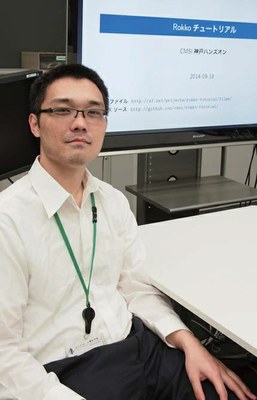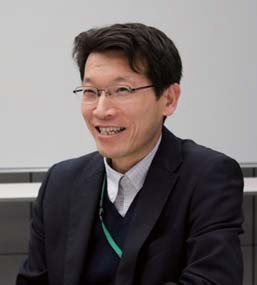4th Divisions of CMSI CMSI Kobe Branch
CMSI Kobe Branch
 Tatsuya Sakashita
Tatsuya Sakashita
The CMSI Kobe Branch is located at RIKEN Advanced Institute for Computational Science (AICS), which is the home of the K computer, and serves as the center of activity for researchers using the K computer, including researchers in the fields of condensed matter physics, molecular science, and materials science. Here, Tatsuya Sakashita talks about the activities carried out at the Kobe Branch.
The Closest Research Center to the K Computer
Under the Institute for Solid State Physics at the University of Tokyo, the CMSI Kobe Branch was established in April 2011 as a branch of the Center of Computational Materials Science. The branch occupies a room having closest proximity to the K computer on the 5th floor of AICS, which is located on Kobe Port Island.
While it is now possible to log in and use the K computer from anywhere, only researchers in AICS had access during its initial trial period that lasted until September 2012. At the time of my appointment there, CMSI researchers from all over Japan congregated at the CMSI Kobe Branch and were immersed in research work day and night.
The CMSI Kobe Branch has work spaces for seven visiting researchers and a fourteen-seat conference space equipped with a large monitor and videoconferencing system that is freely available to all those in residence. This space has been used for computational materials science seminars and has served as a receiving sit for CMSI distance learning (refer to Torrent No.8) and seminars. CMSI Kobe Hands-on and TOKKUN! (application advancement training camp) introduced below have also been held here.
Hands-on Workshops and TOKKUN! for Application Promotion and Advancement
CMSI not only conducts leading research on computational materials science through large-scale simulations on the K computer, but also actively publicizes its achievements in application development to promote these applications both domestically and overseas (refer to the article on MateriApps in Torrent No.8). As a part of these efforts, CMSI has held a monthly workshop (Kobe Hands-on) at the CMSI Kobe Branch. In these workshops, participants use cluster workstations provided for both visualization and post-processing of computational data from the K computer to learn operational procedures while actually running programs.
To date, the workshops have covered various applications developed at CMSI, including ALPS, OpenMX, xTAPP, Rokko, feram, FMO in GAMESS, FU, MODYLAS, and SMASH, as well as a version control system, which is now an essential tool for software development. With each installment, the workshops have become richer in content for beginners, intermediates, and experts (developers) with varying levels of difficulty and purpose. The workshops also have a benefit for developers in that they are able to attract new users to their applications and receive feedback, including suggestions on the need to add functionality and to make the software more user-friendly. The events have also provided opportunities for developers to integrate applications that have been developed independently.
TOKKUN! is a training camp at which participants can bring their own programs and perform tuning at the serial and parallel levels for successful application to the general use category of the K computer. Participants in TOKKUN! receive advice from CMSI division researchers, system engineers from Fujitsu, and researchers from the Research Organization for Information Science and Technology. This camp also offers a great opportunity to learn from experts while discussing programming with other participants in a relaxed atmosphere. Discussions on how to use applications developed at CMSI, including OpenMX, FMO, and MODYLAS, were introduced in the last installment of TOKKUN!
Integrating Fields through Large-Scale Parallel Computing
In addition to the above events, the CMSI Kobe Branch has hosted Informational Exchange Workshops on K computer and HPCI Supercomputer Use for sharing experiences in performance tuning and application use, CMD® Workshops, and CMSI Young Researcher Technical Workshops as well as the CMSI International Workshops 2013 and 2014 (refer to Torrent No.9) that took up the topic of tensor networks in an event closely connected with particle physics, nuclear physics, and astrophysics. In addition, press seminars for presenting results of simulations on the K computer to a general audience and TCCI (Theoretical and Computational Chemistry Initiative) seminars were planned and carried out with AICS.
As supercomputers enter an age of massively parallel computing, collaboration among researchers of hardware, software, physics, chemistry, and mathematics, among other fields, will be essential to develop methods of high-speed, high accurate calculations and to create user-friendly software. AICS is the first research institute in Japan to gather researchers of so many disciplines in one location. We will continue to develop the CMSI Kobe Branch as a new testing ground for integrating fields through large-scale parallel computing by promoting exchange with neighboring researchers in computational science, including the AICS research teams, and utilizing the nationwide CMSI human resource network in computational materials science.
 |
Message from the Director of the CMSI Kobe BranchTaisuke Ozaki
In his best-selling book entitled Capital in the Twenty-First Century, Thomas Piketty predicts that the rich will only get richer in a capitalist society. While I only have a superficial understanding of his work, it seems to me that the same situation is occurring in the development of simulation software. In Japan, software development tends to be considered a side business, and I have heard few successes of producing de facto standard software in scientific and engineering fields of Japan. The development of de facto standard software normally takes a period of twenty years or more, and once relative merits of software imperceptibly appear, information and personnel become consolidated and development progresses at an accelerated pace. Any distinctions that emerge at this time are already past the stage of correction and can lead to a gulf that takes more than ten years to bridge. At CMSI, we precisely assess the situation, discuss what needs to be done to develop software, and take suitable steps to aid our developers. It is our hope that these actions will bear fruit in the development of world-leading software. |
|---|
K Computer News“Flagship-2020 Project,” a project aiming at development of the post-K supercomputer which becomes succession of the K computer, has started. It is planned that the post-K supercomputer will have many-core architecture using general-purpose CPUs, and realize exa-scale computing* by around 2020. Development of application software for the post-K has also started. For that purpose, 9 top priority research topics have been set from the wide field from basic science to the disaster prevention/environmental problems For the 5th priority research topic “Development of New Technology for Highly-efficient Energy Creation, Conversion/ Storage, and Use,” 9 institutions (representative: Institute for Molecular Science) have been selected. For the 7th priority research topic “Creation of New Functional Devices and High-Performance Materials for Next-Generation Industry,” 9 institutions (representative: Institute for Solid State Physics) have been selected. From now on, the development of next-generation application software for computational materials science will be advanced in cooperation with computer scientists. * “Exa” stands for 18th power of 10, 100 times of K. |
|---|

